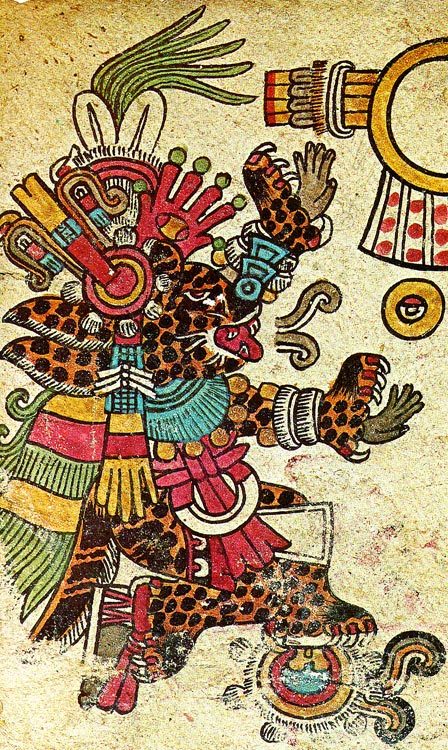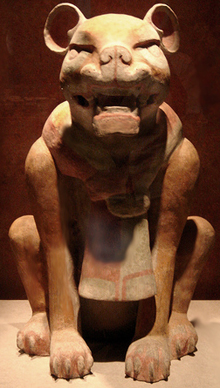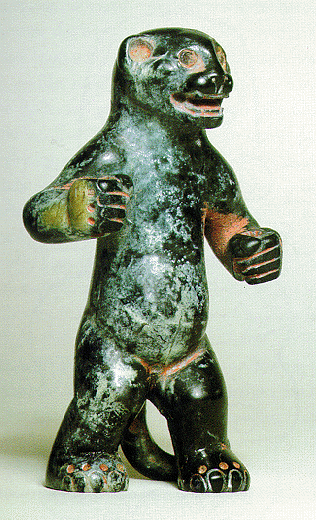We definitely could guess, but we're always willing to talk about jaguar awesomeness with you, Griff!
Mesoamerican and South American mythologies abound with jaguar gods and magical jaguar heroes. This is one of the things that sometimes confuses people into thinking that all those south-of-the-equator religions are the same or mostly the same, but of course that's not what's going on at all; what's going on is that jaguars are the apex predator of that area as well as stunning to look at and violently dangerous toward mankind, and as a result they're a natural place to turn to for mythic tales and symbolism. Jaguars are all over southern American mythology for the same reason lions are all over middle eastern mythology and bears all over northern American mythology; those are the big, obviously important, possibly divine and definitely scary creatures of those areas, so they naturally become associated with gods and monsters.
Of course, the jaguar god we all know and hate to love the most is probably Tezcatlipoca, the Aztec god of darkness, the night, scary magical shenanigans and being relentlessly horrible to everyone else in his pantheon. Not only is he frequently shown with jaguar attributes or body parts, but thanks to the Aztec concept of the nahualli, he is a jaguar in his other half, Tepeyollotl, the heart of the mountain, who was conceived of as so monstrously strong and terrible that he could cause earthquakes and disasters with his flailings. When Tezcatlipoca was the sun and Quetzalcoatl knocked him from his preeminent position in the heavens, he destroyed the First World by having every living thing in it eaten by jaguars, which is probably not in anyone's top ten ways to go. Forget zombie apocalypse; jaguar apocalypse is fucking terrifying.

Tezcatlipoca as Tepeyollotl, wreaking the usual amount of havoc
A little bit south of the Aztecs we come to the Maya, who have several jaguar-related deities, the most prominent of which is Ix Chel, the scary old goddess of flooding, wisdom and doing whatever she wants, much to everyone else's discomfort. Jaguar imagery is extremely widespread among Maya gods and many of them may sport jaguar spots on their faces or jaguar fangs in their mouths as well as the "jaguar eye", a particular way of drawing a square eye that denotes a connection to the animal, and Ix Chel often turns up with these as well as fearsome jaguar claws on her fingers. She's credited with giving birth to several children who were jaguars, although the myth isn't always clear on whether these wree normal animals - making it perilous to kill jaguars without possible incurring her wrath - or jaguar gods. Right behind her is Xbalanque, the second half of the famous Hero Twins, whose very name includes the Maya word for jaguar ("balam") and who also tends to appear with jaguar attributes (especially jaguar fur on his body and face), which probably helped him and his brother manage the terrible House of Jaguars in Xibalba without being eaten alive on their way through. The sun god of the Maya, K'inich Ahau, is also often credited with being a jaguar deity, thanks to similar iconography and a few mentions of jaguars as his totem creatures as well as strong connection to the Terrestrial Jaguar God or Underworld Jaguar God, believed to be the form he takes on when he brings the sun through the Underworld during the night, but since he's the sun god there's some mention of those being "golden jaguars", which might suggest that the Maya were actually talking about pumas they encountered in the mountainous areas of their territory. We like that approach and it's the one we used in the K'uh, because we've got way enough jaguars around here already, but he also might be considered a jaguar god to be reckoned with.

Ix Chel looking terrifying as usual, with a jaguar in one hand among other animals

A Yaxchilan Maya king impersonating Xbalanque in a ritual dance, complete with full jaguar spots

K'inich Ahau as the Terrestrial Jaguar, about to charge through the underworld like a boss
And that's really just a small sampling of jaguar gods from the Maya, who are alllll about jaguars, all the time, anywhere you can name. I can think of at least three more that are probably running around at Legend 10 or so.
And, of course, who can forget the Olmecs, the old and mysterious early culture of Mesoamerica who we know very little about and who various weird New Age magazines seem to think were aliens? The Olmecs didn't leave any writing we can decipher and were around so much earlier than most of the other Mesoamerican religions that most of their artifacts have been badly damaged, but we know they were all about some jaguars, most aptly expressed by this monstrosity of a thing we found:

The Seated Jaguar God, or so some scholars kind of suppose
What is that thing? Who is it? We have no idea, but it's got the fangs and it's large and in charge.
Further south, the Inca people don't have an official jaguar god in their pantheon, but instead have mentions of dangerous jaguar monsters that must be overcome or harnessed by the gods in order to keep things running smoothly. One myth mentions that Viracocha, the creator-god of the pantheon, had to defeat a rampaging jaguar when he created the world lest it devour all his creations; another popular belief is that lunar eclipses are in fact the same jaguar monster attacking and attempting to swallow Mama Quilla, the moon goddess, leading to the Inca practice of running outside, making a lot of noise and throwing things at the sky in an attempt to help frighten it off and save her. When most of the world's mythologies say "OMFG ECLIPSE HIDE EVERYONE HIDE", you have to give props to the people who instead go "OMFG ECLIPSE GET OUT THERE MEN GET OUT THERE AND SHOW IT WHO'S BOSS". But the lack of an official god of jaguars doesn't prevent them from still being a huge deal in Inca mythology; one of their most important magical phenomena is that of the runauturuncu, literally man-jaguar, which is basically about what it sounds like - a scary magical were-jaguar. Many ceremonial Inca sites and works of art show priests and servants of the gods able to turn into jaguars, and in modern Quechuan myth the story has also grown up that anyone can become a runauturnucu by making a deal with Supay, the god of mines and death (although of course making deals with Supay is a terrible fucking idea but you know people do it anyway).

A runauturuncu, looking pleased about life, because what's not to like here?
But the Inca are far from having the monopoly on were-jaguar shenanigans down south of the equator. In the rest of South America, there are fewer of what we tend to think of as "formal" mythologies - that is, there are certainly tons of people with their own unique mythology and religions, but few that are as large and hierarchical as the Inca or the pantheons of Mesoamerica, leading to lots of small religions with only two or three gods or less formal animistic religions that believe in spirits and natural powers but not necessarily gods. But you'd better believe they believed in jaguars, especially the peoples of the Amazon, who were quite aware that being eaten by a jaguar was a real possibility for the end of their lives if they weren't careful on hunting trips and traveling missions. Several of the native peoples of Bolivia and the northern rainforest center their entire spiritual life around jaguars - their bones and semen are used for ritual medicine and potions, their furs worn for protection, their good nature invoked to ease hunting, and young men in some areas even today still have to go on a jaguar hunt to prove their adulthood (in fact, this is the reason that Bolivia is sadly one of the few South American countries that still allows trophy hunting of the endangered animal in spite of international conservation efforts - the jaguar hunt is very ingrained and the government isn't particularly worried about rooting it out). Other parts of the Amazon abound with stories of anthropomorphic jaguars - either people who can turn into jaguars or jaguars who can turn into people, or weird hybrid creatures that embody both - and the stories of their activities vary with an endless variety of craziness. Some say that jaguars devour the souls of the dead, others that it was jaguars who granted mankind fire and taught them how to hunt, still others that jaguars are the "brothers-in-law" of humanity and therefore off-limits for hunting or irritating, and a million other little things depending on a peoples' location and how many jaguars they had to deal with in ancient times.
No discussion of the Amazon mythologies is complete without the total wackiness of the Guarani, a southern Amazonian ethnic group that has some of the scariest and most monster-heavy mythology on the entire continent. Their jaguar god goes by the name of Teju-Jagua (literally "lizard-jaguar", in the Tupa language which is where we get the word "jaguar" from, by the way - before that, the Europeans just called them "American tigers") and is one of the monstrous sons of Tau, the evil oppositional god who plagues the pantheon with his trickery and general jerkfacedness. Because he was the son of Tau (and the product of rape, in most stories), he was cursed by the moon goddess and mother of the pantheon Arasy, and thus born monstrous and horrifying, with seven jaguar heads grafted onto a scaly iguana's body and the ability to breathe fire and strike onlookers blind with his ugliness. The poor guy isn't particularly beloved by the Guarani for obvious reasons, but the creator god of the pantheon, Tupa, took pity on him enough to calm him down so that he isn't a ravening monster and put him to work guarding the treasures of the earth and water, which keeps him busy so he isn't tempted to go about eating everyone and everything. Even so, smaller versions of him - his children - are said to lurk in rivers and deep pools and drag the unwary in to be eaten, so it generally behooves one to avoid his territories.

What the living fuck, Guarani mythology?
By the way, an alternative tradition identifies Teju-Jagua's heads as dogs instead of jaguars. Possibly because no one can tell what in the name of shit is supposed to be going on up there.

You're really on a Mesoamerican kick lately huh Anne?
ReplyDeleteHey, I answer what y'all ask me! But yes, I am always on a personal Mesoamerican kick. :)
DeleteThis is exactly why I love you guys.
ReplyDeleteJaguars, as you can tell, are my obsession in life, and have been for as long as I can remember. So, there weren't many surprises when I was diagnosed with Asperger's. But they're amazing animals, and it's clear why they were so beloved by the peoples of Latin America (and there's evidence of them being beloved in the American Southwest, where they lived until the 50s).
I love the Guarani myths, but there's so many figures which are probably Titans, and those guys get all the press because they're horrible-awesome. Yeah, Teju-Jagua is great in a "What the actual hell" sort of way. Know what he's a god of? HONEY. Honey and sweet fruit... which he grows so that people can offer it to him and thus placate him and ensure he doesn't eat everything.
Interesting linguistic tidbit: "Jagua", with the j pronounced as a y, actually refers to any predatory mammal, particularly dogs, simply because they're the predator they're most familiar with. Jaguars tend to be called "jaguarete" or "true predator".
However, one of the coolest jaguar gods is, unfortunately, quite obscure, since his myths only come from one source (a good source, since it's Boas and his book "Xingu: The People, Their Myths". It's a great read). His name is Sinaa, and he's the divine ancestor of the Juruna people.
Sinaa was the son of a giant jaguar named Duca and a human woman, and was often seen as a jaguar walking around like a man. He and his sons had a number of cool adventures during floodtimes, and he was the divine teacher of Uaica, a shaman culture-hero who had some interesting shenanigans. He literally had eyes on the back of his head. He continually grew old, but then he'd take a bath, shed his skin, and be young again. His wife was a spider-woman who wove bitching clothes. And he guarded a really large stick holding up the sky. When he was ready to call it quits, he'd pull the stick away and cause the sky to crash into the earth and end everything.
Totally awesome, but a pantheon of one,
Recently jaguars have been coming back into the American SW. Several different jaguars have been spotted in AZ and NM. (Literally spotted, I guess, as they tell them apart by the spots). Sadly, it looks like it's going to stall out because someone is building a big ass fence right across the US/Mexican border that will be inherently jaguar-discouraging. On that note, are there any Hopi/Pueblo, Dine, etc. myths featuring jaguars?
DeleteThat certainly sheds some light on all the linguistic forests I kept getting lost in, Griff - thanks! So it's not that Teju-Jagua is necessarily a jaguar god, but rather that he's a god of predatory animalness, including jaguars. How lovely for him. (He has such a sad life.)
DeleteAnon, I don't know of any that southwestern US-area myths that specifically reference jaguars, but a lot of them refer to big cats that were usually translated as meaning pumas. It's totally possible that some of them originally meant jaguars, though.
You're in luck anon, because I've actually researched that topic prior and, after some scrounging, managed to dig up a source on instances of jaguars in the Southwest cultures. (JSTOR, hope you can read it)
Deletewww.jstor.org/stable/1409436
As for actual jaguars in the southwest... it's a thorny issue. On the one hand, I'd personally love to have jaguars return to the US. On the other hand, it consists of a few males who've expanded their territory, with no real breeding population, and it's not the best place for them right now. A fair number of experts on big cat conservation are prepared to write the U.S. jaguar population off as a loss, because they want to focus efforts on making sure that the populations Mexico southward, which are much more crucial to the species' survival, are made stable and protected (there's a project called the Jaguar Corridor, which seeks to provide an unbroken section of protected areas to allow jaguars to travel and interbreed and prevent habitat fragmentation)
Thank you for the article link - awesome stuff!
DeleteDo I want to know how they got hold of the jaguar semen for the potions?
ReplyDeleteThat insane query from my diseased mind aside, this was an amazing post. I LOVE finding out about how different cultures take the same thing and give it their personal spin!!! And thanks for the extra info Griff! Any chance we could get something similar about the various Raven and Coyote figures in Native American myths? (Hell, why leave it to chance, I think I'll send in a question to that effect).
You know, I wouldn't actually mind seeing a Guarani pdf someday. I mean, I believe we need to populate Oceania and Native America first, but South America should definitely have more than one native pantheon write-up. Everything you and Griff tell have mentioned about it so far on the blog makes them very interesting.
Probably extracted from the testicles post butchering (if I have to live with this mental image, EVERYONE does)
DeleteAnd yeah, Guarani myth is fantastic, but also completely batshit. It's filled with things like cannibalistic monsters and penises so long they're tied around the waist as a belt and vagina-less women getting impregnated by steam, so a fish needs to rip open the crotch and allow it to be born.
Oh, I'd love a Guarani PDF someday, just like everybody else I want to see in Scion. They are totally bananas out of their minds. (Although separating the gods from the Titans is pretty challenging down there...)
DeleteSo Griffinguy24 already knew the answer to the question he posted?
ReplyDeleteTechnically my question was "Can you do a blog about this topic?" Partly because I was hoping they'd add a "jaguars" tag, similar to the "bears" tag, but eh.
DeleteThough this does lead to another question. Anne, do you think that the Inca jaguar-monster you mentioned Viracocha fighting is Ccoa, the feline Storm Titan Avatar?
(It took every ounce of my strength not to make a Thundercats joke there)
I added a tag just for you. :)
DeleteI think it could be Ccoa, but it would depend on the translation, and Quechua's not an area I can go out and do that myself. I've usually seen Ccoa referred to as a "cat" without any specific kind of cat mentioned, and descriptions of the thing usually say her fur is rainbow, which doesn't help pinpoint very much. Most things I've read default her to puma because that would be the most common big cat in the Inca highlands, but jaguar would be equally reasonable as far as I'm concerned. Or both. Maybe Ccoa is whatever big cat it wants to be at that particular moment.